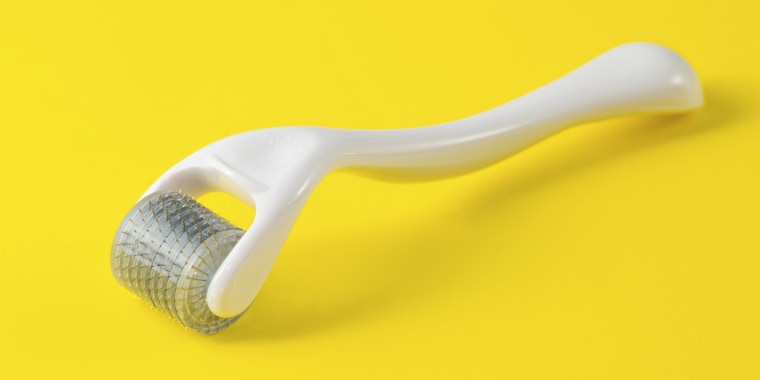Micro-treatments, such as microdermabrasion and microneedling, have been gaining momentum in the beauty world for being fairly low-risk and high-reward. So much, in fact, that you can now scour beauty stores for a range of over-the-counter products and tools designed to help mimic the effects of the cosmetic craze in the comfort of your own home.
But many are still curious about what to expect from the actual procedures and following results. From ridding skin of dead cells, to producing youthful collagen (and plenty of more unconventional uses along the way), read on as experts break down the benefits of microdermabrasion and microneedling.
What is microdermabrasion?
Microdermabrasion, in its simplest form, is a physical exfoliating treatment, according to Dr. Hal Weitzbuch, M.D., M.S., F.A.A.D., medical director at Calabasas Dermatology Center in California. “A device with a rough surface rubs against the skin to remove superficial buildup of mostly keratin and dead skin cells,” he says.
There are two types of microdermabrasion: crystal and diamond. “Crystal is essentially like ‘sandblasting’ the surface of our skin, whereas diamond is essentially ‘sandpapering’ the surface of our skin. Both serve the same purpose of exfoliating and stimulating the production of superficial collagen,” adds Dr. Adarsh Vijay Mudgil, M.D., medical director of Mudgil Dermatology in New York.
Microdermabrasion benefits
Dr. Mudgil says some who undergo the treatment, which can be performed weekly to monthly and typically costs anywhere from $75 to $200, will witness immediate results (such as smoother, brighter skin), whereas others will see results over time.
“This is great for those with superficial acne, blackheads, fine lines and pigment issues. Some believe that the mechanical trauma also stimulates superficial collagen production, which can help with fine lines,” he explains.
Can microdermabrasion be done at home?
While a number of microdermabrasion-focused scrubs and tools are available for purchase, experts say you should try to buy from reputable sources and stick to the real deal if possible. “I recommend the professional treatment as it will always provide better results and will often be safest,” says Victoria Lewis, a medical aesthetician at the Tribeca MedSpa in New York.
What is microneedling?
While microdermabrasion buffs away dead skin cells for a smoother, more radiant surface, microneedling, a newer treatment, involves penetrating microscopic holes in the skin with tiny needles, in turn stimulating what Dr. Mudgil refers to as "wound healing." This can also stimulate collagen production.
“There are two types of microneedling: cosmetic needling and medical needling," explains Dr. Mudgil. "Cosmetic needling uses a short needle to make microscopic perforations in the skin, which stimulates superficial collagen production. Medical needling is similar, but uses longer needles than cosmetic needling and is essentially a deeper, more effective treatment."
Microneedling benefits
Microneedling is generally performed 4 to 6 weeks apart with costs varying anywhere from $200 to $1500. (The upper range usually involves the use of platelet-rich plasma, also referred to as "the vampire facial.") Microneedling can be used to help improve a variety of skin concerns, including acne scarring, fine lines, wrinkles and uneven skin tone or texture. “You will have younger-looking skin with fewer signs of aging,” says Lewis, the medical aesthetician.
Can microneedling be done at home?
Like with microdermabrasion, you can purchase DIY tools on the market, but experts say you shouldn’t expect the same results as they typically don’t penetrate the skin as deeply. "People can also give themselves infections by not cleaning the tools correctly, and can overdo it and cause other issues like post-inflammatory hyperpigmentation,” cautions Lewis.
Microneedling aftercare
As for how to care for your skin post-procedure, Lewis recommends avoiding anti-inflammatory medications such as Motrin or Advil. “These will interfere with the natural inflammatory process that is critical for skin rejuvenation,” she says. Lewis also says to avoid the sun and exercise for at least 48 hours.
Microdermabrasion and microneedling for acne
While microdermabrasion can be used to treat acne, it should only be done so in the case of superficial types of acne (such as blackheads or whiteheads), explains Dr. Mudgil. That said, he recommends microneedling as a treatment for acne scars.
Microneedling for stretch marks
Lewis says microneedling can indeed be used to help the appearance of stretch marks. “It will improve them, but how much depends on many varying factors, such as how dark and how old the stretch marks are,” she explains.
Microneedling for hair loss
Dr. Weitzbuch says microneedling can increase the amount of blood flow and blood supply and, especially when combined with platelet-rich plasma, can help stimulate the growth of hair.
However, Lewis cautions: “Everyone responds differently, so while some people may see a great improvement, some may not.”
“When combined with topical minoxidil (such as Rogaine), patients who had microneedling performed prior to application had a significantly better outcome than those patients who used minoxidil without microneedling,” adds Dr. Mudgil.

